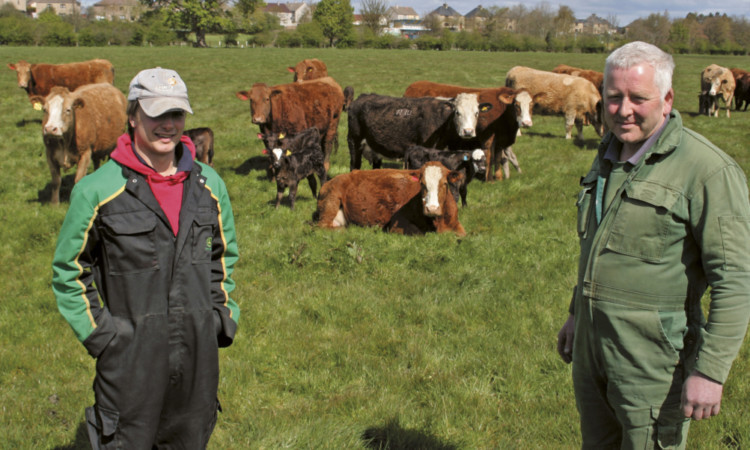Whole-farm profitability is critical to father and son partnership, Alex and Ross King at Wolfstar, Ormiston, East Lothian.
Their suckler and pedigree cattle enterprise has to not only integrate with the arable enterprise but also complement it.
It is for this reason that the Kings have focused on achieving a compact calving period, which does not eat into spring sowing or harvest time and improves the margin per head of their suckler cows.
According to Quality Meat Scotland’s Guide to Improving Suckler Herd Fertility, rearing 94% of calves per cow put to the bull to sale time, combined with a compact-calving period, can increase profitability by £86 per cow.
There are 140 Aberdeen Angus cross Simmental suckler cows and 30 pedigree Simmentals on the farm and in recent years the number of commercial calves per cow reared at Wolfstar has never dropped below 94% and has been as high as 97%.
The Kings also regularly achieve two-thirds of the herd calving in the first three week period and last year only 7% were left to calve in the six to nine week period, which Alex King said he was delighted with considering the weather and cow condition at bulling time in 2012.
He said: “There are only three of us on the farm Ross, one man and myself.
“I am responsible for the arable side and Ross for the cattle but at busy times we have to help each other out and that is why it is so important to calve the cows after spring sowing and before summer work begins.”
Wolfstar extends to 860 acres plus 40 acres on seasonal lets for grazing.
There are 700 acres of cereals, which includes 40 acres of annual grass in the rotation. This is cut twice or three times for silage for cows and youngstock.
In 2012 the Kings won the East of Scotland Grassland Society’s silage prize and were runners-up in the national competition.
The rest of the farm is grass and the set-up makes for easy cow management, with paddocks in a circle round the handling pens.
Alex King said: “We prefer to calve the cows outside for health reasons and we graze them quite intensively until they calve so they do not get too fat.
“Then once they have calved it is easy to push them into the next field for fresh grass.
“Heifers and pedigree Simmentals are calved inside and turned out after calving.”
The compact-calving period is achieved by several means.
Bulls go to the heifers 10 days before they go out with the cows and are only with the heifers for six weeks.
This means there are no late-calving heifers, which have traditionally been difficult to get back in calf.
Bulls are with the cows for nine weeks and anything which does not hold in nine weeks is culled.
Bulls are pre-breeding soundness checked and the herd is a member of the Premium Cattle Health Scheme, having achieved risk level 1 for Johne’s and accredited free of BVD.
Home-bred heifers are selected on growth, shape, feet and temperament while non-home-bred Simmental and Aberdeen Angus bulls are selected on a combination of visual assessment and EBV evaluation.
QMS knowledge transfer specialist Robert Gilchrist, said: “The Kings’ policy is a great example of good heifer selection andmanagement, leading to a tight heifer calving.
“Combining this with the close management of the cows and bulls means they maintain that year on year.”
“Only allowing the heifers six weeks with the bulls means that the Kings are testing heifer fertility from day one.
“Heifers that are unable to hold to the bull in two cycles at the point in their life when they are under least pressure can be identified in this system. This allows the Kings to focus on the most fertile heifers as replacements for the herd.”
Most of the heifer calves, which are not retained in the herd, are sold for breeding and, in fact, Mr King observed that last year only six were sold prime.
He said: “We have good customers who come back year after year for heifers and because of our high health status, the heifers are popular in pedigree herds for recipient programmes.”
Around 80% of the steers are sold at 12 to 14 months on a finishing ration, based around home-grown winter barley.
They are sold to AK Stoddart at Ayr, averaging 320kg deadweight and U and R grades.
Mr King added: “Another benefit of the tight calving period is that we have an even batch of finished cattle to sell the following spring.
“The majority are away in June and July but any smaller calves, twins or heifers’ calves are wintered with the female calves on silage and straw before a summer at grass and finished over the following winter.”
The management of the cattle dovetails neatly with the arable enterprise.
Straw and winter barley are used on the farm and the dung helps the fertility of the cereal fields.
Mr King added: “We adopt a whole farm policy at Wolfstar the profitability of the arable side depends on the soil fertility the cattle provide and vice-versa.”
This does not stop some friendly father/son rivalry each year, however, when they compare margins from their enterprises to see who is doing better.
“There is no doubt that Ross has been winning that battle in the last few years with the cattle, especially if he takes into account the pedigree Simmentals,” observed Mr King Sr.
